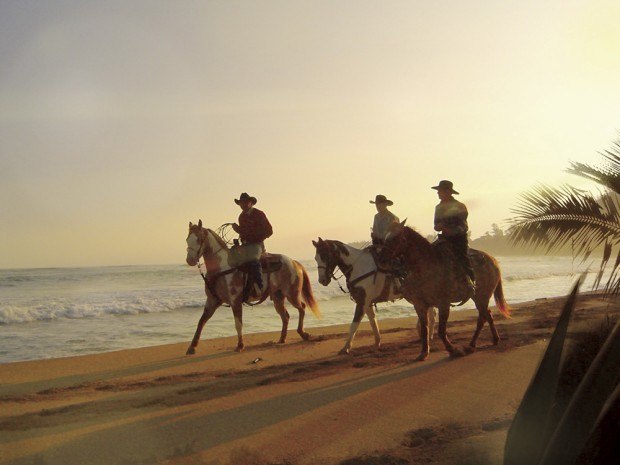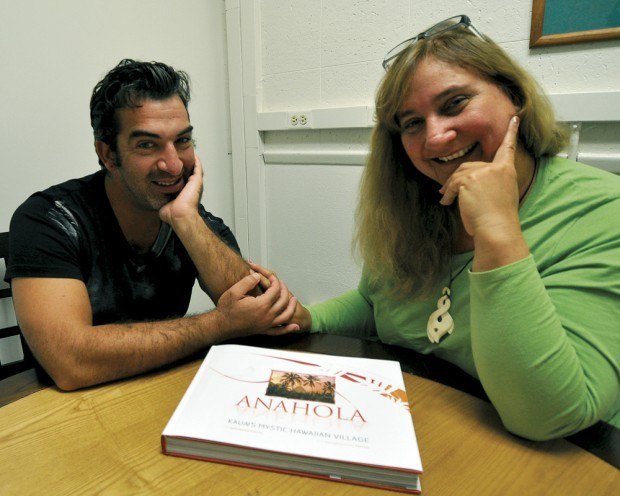Mele, oli, legends, art, stories and over 100 photographs come together in a collection celebrating the village of Anahola with the recent publication of “Anahola: Kaua‘i’s Mystic Hawaiian Village” by Agnes “Aggie” Marti-Kini. Come to Kaua‘i Museum at 11 a.m. Saturday for a presentation and book signing with the author.
“Anahola: Kaua‘i’s Mystic Hawaiian Village” is something of a travelogue.
“I wanted it to be a pictorial history of Anahola,” said Marti-Kini. “Historical — but not a boring history book.”
In collaboration with graphic artist Adam Prall, the two sought to reveal the hidden face of an area touted as the birth place of all souls by the Dalai Lama on his visit to Kaua‘i 15 years ago.
“When the Dalai Lama came to Hawai‘i in 1994 he told his (tour guides) the two places he wanted to visit on Kaua‘i were Polihale and Anahola,” Marti-Kini said. “Because Polihale is the place where souls leave for the next world and Anahola is where souls enter the earth.”
While doing research for the book Marti-Kini learned from her Hawaiian editor, Kumu Ka‘e‘eonalani, that the original spelling of Anahola was “Anehola” with an “e.”
“‘Ane’ means ‘the breath of life,’” Marti-Kini pointed out. “‘Hola’ means ‘the hour.’ The two words together translate as ‘birth.’”
The creation of this prayerful volume was nothing short of a birth, employing many hands to midwife the project. After altercations with a publishing house not sharing Marti-Kini’s vision, the 35-year Anahola resident opted to self-publish with the kokua of a supportive editorial staff, all volunteering their hours.
“It’s the Hawaiian way,” she said. “You give of your talent.”
A quote by Emmaline White included in the book captures the historical significance of kokua.
“Everyone took care of their ‘ohana and anything extra was shared or traded for other supplies that they did not have. That’s just how it was back then.”
The impetus for the book arose five years ago when Marti-Kini’s daughter, Summer, sought to write a paper for school on the ahupua’a of Anahola.
“The project was to include a kupuna testament, an oli, legend and maps,” Marti-Kini said. “She couldn’t find anything (documented) until she spoke to Auntie Emmaline White. At the time I said, ‘Wow, someone should write a book about Anahola.’”
Later Marti-Kini had a vision confirming her decision to take the project on — that vision became a “kaheo” or “calling,” she said.
“And then everything was revealed,” she said. “Once I made a list of kupuna it started to manifest without any effort.”
Following Hawaiian protocol the book opens with a pule (prayer) followed by an oli (chant). The four chapters cover the region, history, people and wisdom preserved by kupuna.
“The book virtually is taking a journey. There is no beginning or end,” Prall said. “It’s more the aspects of what you’d pay attention to on a journey.”
The two describe the book as a cross-cultural project for both native and visiting populations that includes cultural insights in both English and Hawaiian.
“Having it in Hawaiian was important,” she said. “Perpetuating the language is how you perpetuate your culture.”
Marti-Kini was born to a pure Hawaiian father, John Ka‘apuni Kini and a German/Austrian mother from New York. For the last 35 years she’s lived with her ‘ohana in the village township of Anahola on the Hawaiian Homestead farm lots.
Other editors on the project were Bryan Peterson, Sylvia Partridge and Eve Lampenfeld.
“It is a book authored by the community people themselves,” Marti-Kini wrote in an e-mail. “I am just the vehicle by which their histories were recorded and preserved…”
A second signing is scheduled for 2 p.m. March 27 at Borders Books and Music. For more information call 346-0473. To order the book on-line visit anaholavillage.com.






